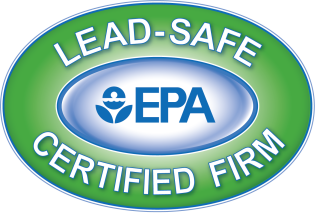Is attic mold dangerous? Can mold cause health problems? In one word – Yes. Attic mold can cause health problems from allergies to mental health impairments. Mold is not something you want in your home! You may be wondering, how did the mold get here, and how do I get rid of it?! Can I DIY or do I really need professional help? We answer all your questions and more.
DISCLAIMERS:
Blog information is NOT intended to provide or replace medical advice. NO information on this site should be used to diagnose, treat, prevent or cure any disease or condition.
*As an Amazon Associate we earn from qualifying purchases.
Suggestions for products to use are just that, suggestions. You know yourself and your home best. Please do your own research on any product you use in your home or on your skin, and learn all the facts for yourself. Thank you.
WHERE DID THE ATTIC MOLD COME FROM?
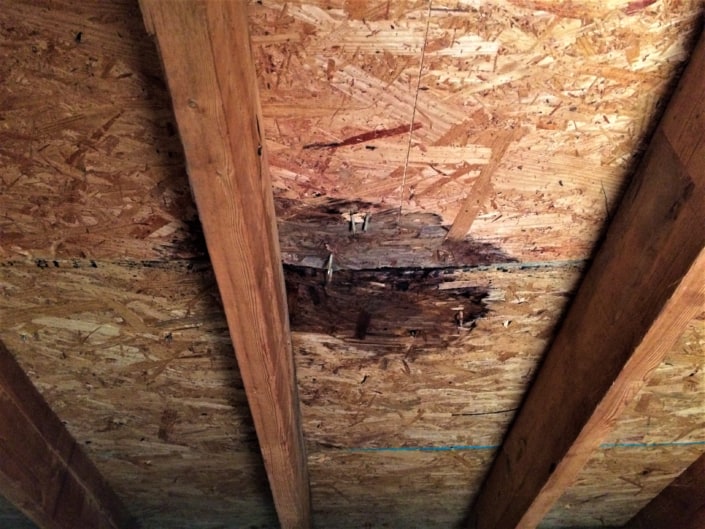
Molds grow from microscopic spores that are everywhere in the air. Molds are found everywhere in nature, including your attic, and are important for recycling organic matter (such as leaves). The recycling process they perform returns nutrients to the soil and is important for plants to grow.
Attics have all the things mold needs to grow: food (drywall, cardboard boxes, wood, leather goods, etc.), oxygen, the right temperature, and moisture.
Food Sources
Molds grow inside of their food sources. They penetrate deeply into wood, insulation, drywall, carpets, underneath kitchen and bathroom sinks, etc. Anything with carbohydrates in it could be considered a food source for molds.
Moisture
Moisture is the one thing you can reasonably control when it comes to mold. A dry home equals a home with less mold growth. Keeping areas dry, especially areas that use water frequently (like bathrooms), is important to prevent mold growth.
Humidity higher than 60% gives mold a perfect environment in which to grow. The good news is you can prevent attic mold from causing problems. Controlling moisture levels stops mold growth in its tracks.
How Fast Do Molds Grow?
Once enough moisture is present, molds can begin to grow in less than 48 hours! Water from leaks, condensation, and poor ventilation can cause a ticking mold time bomb. Time is not on your side! Keep reading to learn what to do next.
WHAT ARE THE MAJOR CAUSES OF ATTIC MOLD?
Have you been up in your attic lately? Most people never venture into this part of their homes. Attics can easily be infested with mold for 2 primary reasons – poor ventilation and roof leaks.
Roof Leaks
One of the most common causes of mold in the attic is a leaking roof. To check for possible roof leaks, look for discoloration of insulation and wood including: the rafters, sheathing, joists, fascia boards, roof valleys, skylights, chimneys, windows, flashings, and the like. While you’re up there, make sure there are no leaks around attic plumbing stacks or air conditioners. If you have a vapor barrier, check for condensation. You may also be able to smell it. Mold has a distinctive musty odor that has been compared to stinky gym socks or a wet dog kind of smell.
Roof penetrations are one of the most likely places to find leaks. At least twice a year, roofs should be checked for leaks. Attic mold is often caused by the buildup of moisture that can not escape. One easy way to tell if you have excessive moisture in the attic is to look at the nails. If they are rusted, you most likely have moisture and ventilation problems. Black spots and discoloration can also signify a leak and mean trouble.
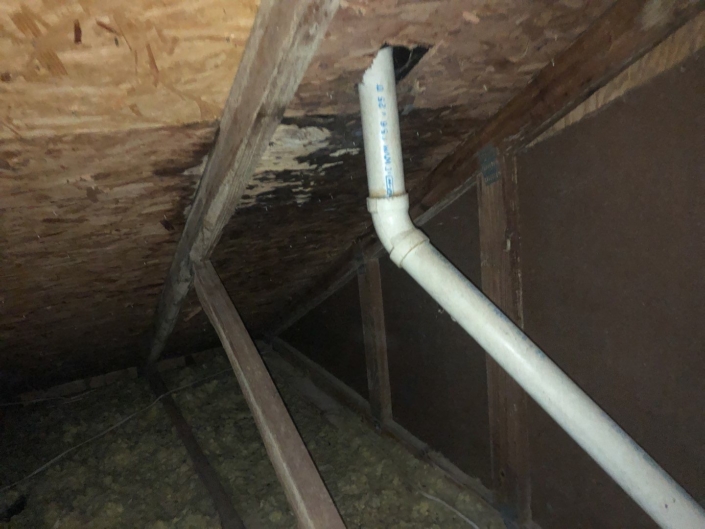
Check that caulking and flashing are secure and in good shape. Repair missing or loose shingles, damage from limbs and remove any moss. While you are on the roof (or your chosen repair technician is), be sure to inspect the chimney for loose bricks, or boards. Also, check that the flashing is secure, and that no water is passing through it. Be sure a chimney cap is installed and working properly.
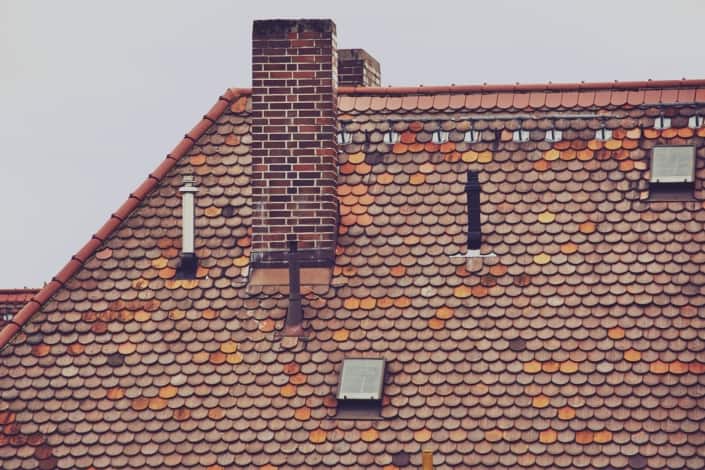
Poor Ventilation
Because air travels upward toward the attic, household activities such as cooking, bathing and showering will produce moisture that can make its way to the attic and become trapped. Rusted nails and discoloration of wood are clues that there is too much moisture in the attic.
For more information about water damage check out our post: Top 10 Ways to Prevent Water Damage.
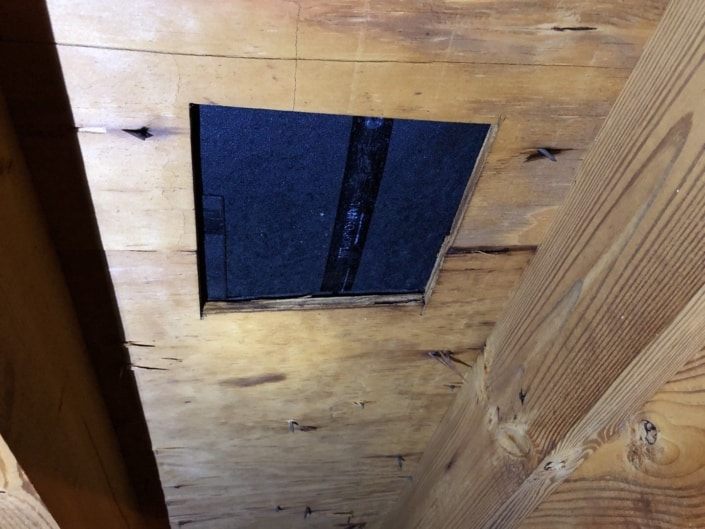
Why Proper Attic Ventilation is Important
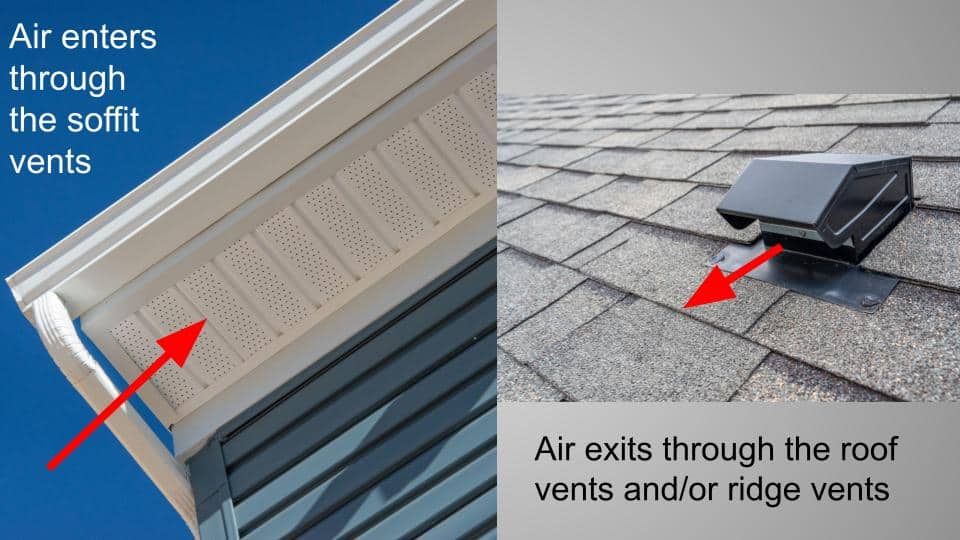
Proper roof ventilation is very important in keeping your attic dry and mold free. Most homes have a passive system to circulate air through the attic. Around the ridge of your roof are soffit or eave vents that allow external air to enter the attic. This air then warms up in the attic, and leaves through can or ridge vents because heat rises. The process of air moving through the attic creates a well ventilated space, and prevents moisture and heat from being trapped.
However, when air is unable to enter or leave the attic, moisture and heat build up and encourage mold growth. If the soffit or eave vents are blocked (by paint for example), fresh air cannot enter the space. If the ridge vents or can vents are blocked (or not present), moisture and heat can build up in the space with nowhere to go.
We have visited homes with mold and moisture problems where there were no ridge or can vents and others where there were soffit or eave vents were blocked. Never assume these things are in place and working properly! Be sure to include checking these vents as part of your home maintenance routine.
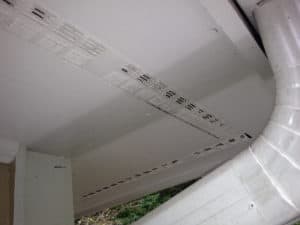
Other Types of Improper Ventilation
Other types of improper ventilation can also cause moisture problems. Improper ventilation of bathroom fans or dryer vents into the attic space can increase moisture and heat in the attic. Yes, we have seen these problems in real customer’s homes, and we have helped fix them! Our customers know we go above and beyond to find the problem and be sure it is corrected.
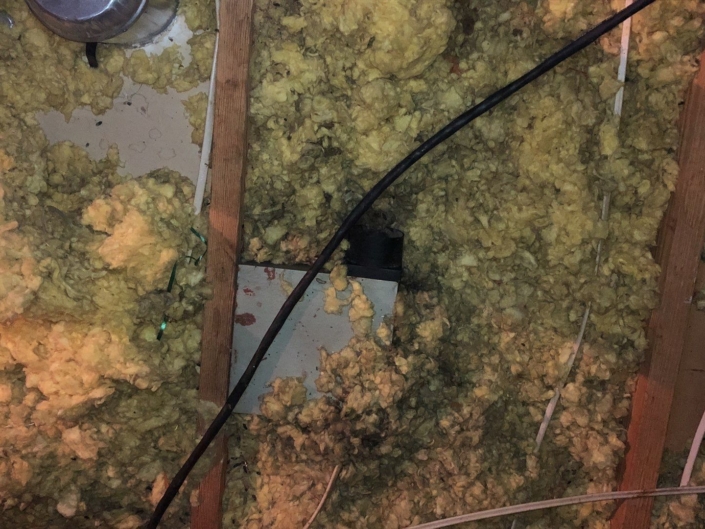
IS ATTIC MOLD DANGEROUS? HOW ATTIC MOLD EFFECTS YOUR HEALTH

Mold is an insidious, invisible predator in your home. It hides in places no one ever thinks to look like under cabinets, in crawl spaces, attics, and behind furniture. People may spend weeks, months, and even years fighting illness, and never know what they are really fighting…mold. Many of our customers find us after a recommendation from their doctor, that they may in fact have a mold problem, and not just an illness.
Mold is most often associated with allergies, but mold is much more menacing than people know. While all molds have the potential to cause irritation and allergy symptoms, molds can also cause much more dangerous health problems including: fungal poisoning and mental health problems. You can learn more about mycotoxin poisoning in our article: When Mold Is Worse Than Allergies.
To learn more about how mold can affect mental health check out our articles: Mold and Mycotoxins: Effects on the Brain and Nervous System in Adults and Effects of Mold on Children’s Health.
To learn more about one of our customer’s real homes, and how we helped solve their attic moisture problem check out our post: How Does Mold Affect Your Health?
BLACK MOLD – SOMETHING OF A MISNOMER
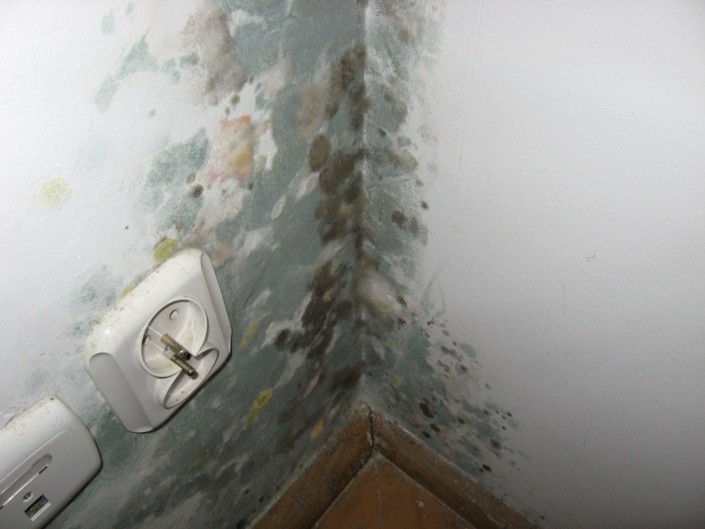
Before we go any further, let’s clear up the confusion about ‘toxic black mold.’ When you read about ‘toxic black mold’ it is kind of misleading. The thing is… dangerous and toxic mold is not just black, it can be many different colors. Toxic molds can appear to be green, yellow, brown, and black.
All molds have the potential to cause irritation and allergy symptoms. However, some molds can also cause much more dangerous health problems. Some molds, but not all, produce mycotoxins. Not all molds are toxic, but many are. Mycotoxins can cause health problems ranging from poisoning to cancer.
So, What is a Mycotoxin?
Mycotoxins, literally ‘fungus poison’ in Latin, are secondary metabolites that can be produced by molds, and are not living organisms. Mycotoxins are a byproduct of mold. Not all mold spores produce mycotoxins, but some do. So the molds that produce mycotoxins are the ones that could be categorized as toxic or poisonous.
So, where is the line between an allergic mold and a toxic mold? That line is defined by the presence of mycotoxins, and is NOT defined by color. Mycotoxins are invisible and cannot be detected just by looking at the mold growth.
What Do Mycotoxins Do?
These chemical substances can cause many health problems ranging from mild to severe. Even if you are not allergic to mold, you can be affected by mycotoxins.
Mycotoxins can be absorbed by the body in a number of ways including: through the skin, the airways (inhalation), and through the intestinal lining (ingestion). Detrimental health effects caused by mycotoxins can range from “acute poisoning to long-term effects such as immune deficiency and cancer.”2 Chronic disease sufferers, such as people with immunosuppressive disorders or underlying lung disease may be more sensitive to molds and mycotoxins in their environment.4
One of the main ways people and pets become poisoned by mycotoxins is through eating contaminated foods. Foods such as apples, cereal grains, coffee beans, nuts, spices, dog and cat food, and more can become contaminated with fungi that produce mycotoxins.
To learn more about mycotoxins in foods check out the World Health Organization’s article: Mycotoxins.
Did you know that toxic mold can affect your pets as well? To learn more about how mold affects your pets check out our article: Mold and Pets – 10 Things You Most Likely Didn’t Know.
IS ATTIC MOLD DANGEROUS? – MOLD EXPOSURE SYMPTOMS

Even for people in good health, exposure to large amounts of mycotoxins and molds can overwhelm the immune system and cause symptoms of poisoning. Mycotoxins can be especially dangerous for people with compromised immune systems. Symptoms that are associated with allergic reactions are highlighted in italics.
Some of the symptoms associated with mold and mycotoxins can include:
- Chronic burning in the throat and nasal passages
- Coughing, wheezing, and shortness of breath
- Eye irritation – red eyes, blurred vision
- Headache
- Skin rashes
- Fatigue
- Loss of balance
- Dizziness and Disorientation
- Reduced color distinction
- Depression and/or anxiety
- Light sensitivity
- Vertigo
- Feeling lightheaded
- Morning stiffness, joint pain and/or muscle pain
- Muscle weakness
- Slower reaction time
- Poor memory, difficult word finding
- Difficulty concentrating
- Unusual skin sensations, tingling and numbness
- Appetite and mood swings
- Body temperature regulation problems
- Increased urinary frequency, increased sweating (especially at night), or increased thirst
- Abdominal pain, diarrhea, bloating
- Metallic taste in mouth
As you can see, the list is quite long! It is also not a list of symptoms that would immediately point a doctor to a specific illness. Some symptoms (like the symptoms associated with allergies) manifest immediately, but others such as poor color distinction, dizziness, fatigue, poor memory, and difficulty word finding may take months or years to develop.
Please remember that this blog is NOT intended to replace medical advice, diagnosis, or treatment.
Always talk to your doctor about symptoms of any medical condition you are experiencing. It is unlikely to experience all the symptoms listed, but many of these symptoms could be cause for concern. An open dialog with your doctor is important for any medical condition. Ask questions to be sure you understand your diagnosis, treatment, and recovery process.
To learn more about our sources of information, please check out the ‘For More Information’ section at the end of this article.
HEALTH EFFECTS OF MOLD ON ADULTS, CHILDREN, AND PETS

In the long term, mold can cause dangerous health problems for adults, children, and pets. If you suspect you or family members are suffering from mold exposure, talk to your doctor, pediatrician, or veterinarian.
If you think you need a mold inspection for your home or business, get in touch with us, and we’ll get down to the source. Here at Branch Environmental, we know your health is your priority, and we see each mold inspection as an in-depth investigation.
Adults
Adults that have been exposed to mycotoxins can exhibit symptoms such as disordered brain function, changes in balance, slower blink reflexes, slower reaction times, color discrimination problems, and depression. For adults exposed to mold and mycotoxins, scientists have discovered that brain function of adults exposed to mold is abnormal or significantly decreased compared to those who have not been exposed to mold. Remember that even if you are NOT allergic to mold you can be affected by mycotoxins.
To learn more about how mold affects the brain check out our post: Mold and Mycotoxins: Effects on the Brain and Nervous System in Adults.
Children
Children that grow up in homes with mold are more likely to suffer from allergies and asthma than children that live in homes without mold. Mold also appears to affect cognitive or brain development in children.
A scientific research group from Poland studied the effects of mold on children’s IQ development from birth to six years old.10R IQ scores were used to determine intelligence level at 6 years old. Study participants were compared to children who lived in homes without mold. They found that children who lived in homes with mold, especially those who were exposed to mold for longer periods of time, had triple the risk of low IQ scoring.10R Even accounting for differences in maternal education level, students who had lived in homes with mold for longer periods of time had a much higher risk of lower IQ scores.
Pets
There are two different ways pets can be exposed to mold including: ingestion (eating mold) and inhalation (breathing mold in the air). Just like people, pets can also have allergies to mold.
Typical allergy symptoms in pets include:
- Respiratory symptoms like sneezing, breathing difficulties, coughing, wheezing, and discharge from the eyes and nose
- Excessive licking or scratching which can lead to fur loss and painful sores
- Lack of energy
Symptoms Caused by Toxic Mold in Pets
While all molds have the potential to cause irritation and allergy symptoms, some molds can also cause much more dangerous health problems. More dangerous symptoms of mold exposure can also be attributed to mold due to the presence of mycotoxins. When exposed to mycotoxins, pets can exhibit symptoms such as:
- bleeding from the mouth or nose
- neurological problems due to mycotoxins (acting strangely)
- digestive problems, such as vomiting and stool changes, including damage to the gastrointestinal tract
- weakened immunity to other secondary diseases
When pets either ingest mold with their food or inhale mold through the nose, they can exhibit these types of symptoms. Unfortunately, symptoms of mold exposure can mimic symptoms of other health conditions making it sometimes difficult to diagnose mold exposure.
The most important thing to remember if your pet is exhibiting these symptoms is to get them to the veterinarian right away! The effects of mold can be reduced if treated early. However, in the long term exposure is much more serious, and can lead to very dire consequences including organ failure.
To learn more about pets and mold go to: Mold and Pets – 10 Things You Most Likely Didn’t Know.
As you can see, living in a home or working in a home or building with mold growth is detrimental for the health of adults, children, and pets. Studies have shown that once buildings are repaired the health of the people begins to be restored. It is difficult to improve your health if you live or work in a building with mold without remediation or mold removal.
To learn more about our sources of information please check out the ‘Research Articles’ section at the end of this post.
DIY ATTIC MOLD REMOVAL VS. PROFESSIONAL ATTIC MOLD REMOVAL

If you’re familiar with our blog, you know that the first thing to do when cleaning mold is to fix the moisture problem that led to the mold growth. Until you fix the moisture problem, mold will continue to grow and spread.
Customers often ask, “Can I clean the mold myself or do I need a professional?” Our answer depends several factors including:
- how extensive the mold problem is
- what building materials, furnishings, and belongings are affected
- where the mold is located
- whether or not you mind being in confined spaces such as your crawlspace, basement, or attic
Mold is great at hiding in hard to detect locations such as in drywall and insultation. If the area of mold covers more than about 10 square feet, there is a good chance the mold problem is more than an isolated issue. If you smell a musty odor in your home you can’t identify, or have health problems associated with mold, it’s time to call in the professionals.
To learn more about DIY mold removal, check out our post Black Mold vs Mildew – 7 Common Misconceptions and When to DIY before cleaning. We give you all the details on how to clean mold safely.
WE’RE HERE WHEN YOU NEED US
Call Branch Environmental. We’re experts not only at mold removal, but at determining and remediating the underlying causes. From hidden mold sources to major contaminants, we can identify exactly what is going on in your home and rid it of environmental toxins, often for good.

WHAT ARE THE STEPS OF PROFESSIONAL ATTIC MOLD REMOVAL?
Let’s say you have a big mold problem. There is definitely more than 10 square feet of mold, you are having health issues, or you have decided DIY is not for you. What happens when you call a professional? When you have a mold remediation company come to your home, you need to know just what to expect.
1. Define The Scope
The work begins with a paid Indoor Air Quality Assessment. A thorough Indoor Air Quality Assessment takes time and resources. The inspector should ask a lot of questions before they come and when they arrive. These questions along with visible inspection of the property, help the inspector pinpoint the source (or sources) of the problem. If a company shows up and gives you a ‘free’ air quality assessment, you’ve probably found a scam artist.
Not all mold removal and remediation companies are created equal. Before hiring anyone you should ask questions, a lot of questions! For a detailed list of questions to ask check our our post: How to Choose the ‘Best’ Mold Removal Company. We help you know all the questions to ask and all the correct answers! If a mold removal company can’t answer all the questions or answer them to your satisfaction… Don’t hire them!
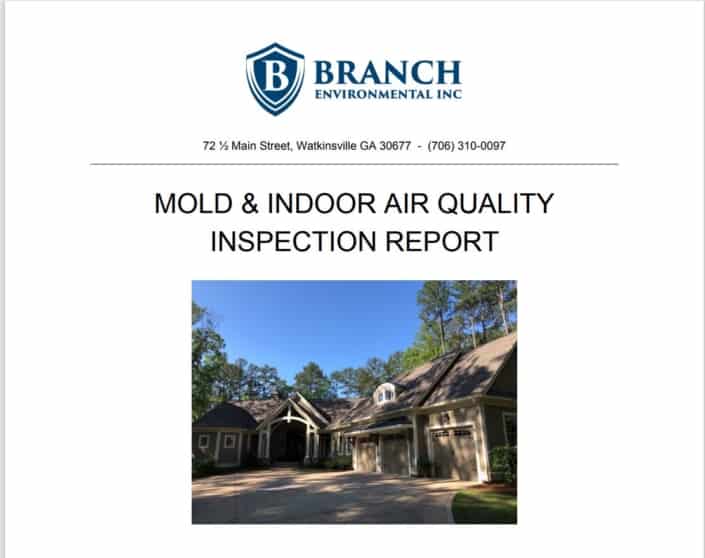
Once the inspection is complete, your inspector will define the extent of the necessary work and what may or may not need to be done. You should receive an Indoor Air Quality Assessment Report that details all the work to be done. The inspector should talk you through all your options and tailor a plan that fits your needs and your budget.
2. Protect The People
Keeping your family and the work crews safe is our top priority. This means preparing your home for the work that needs to be done. Branch Environmental uses methods such as containment walls and negative air to keep your home safe, and we’ll let you know if you can or cannot be in the home during the work. Check out our post Branch Environmental Keeping You Safe to learn more.
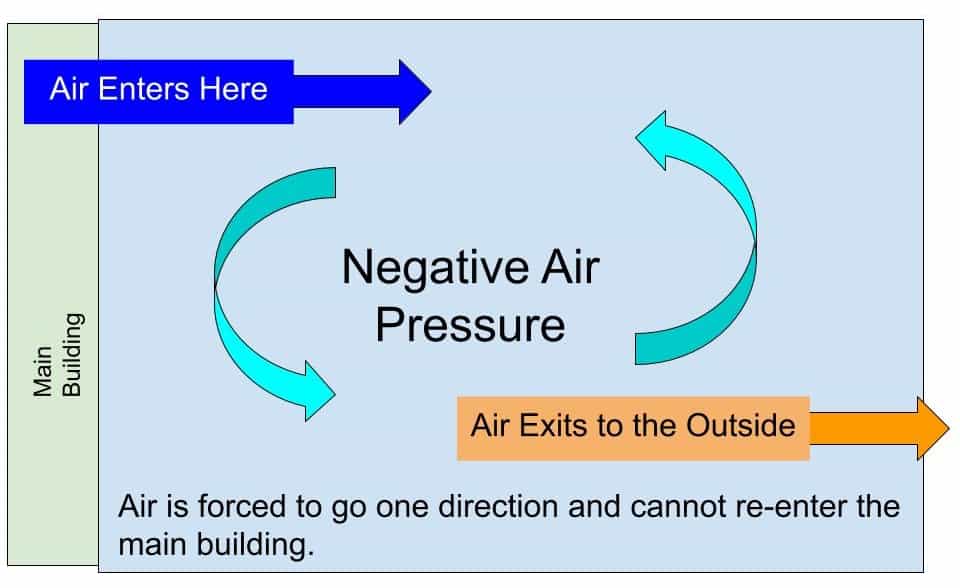
3. Correct Moisture Problems
Removing or correcting the source of moisture is a vital part of the remediation process to ensure mold does not return. This may be handled by a contractor outside the scope of the mold remediation. Once walls or floors are opened up, now is the time to address plumbing issues and other leaks. Leaks are problems that can be remedied quickly if routine maintenance checks are performed on your home. The longer a leak is present, the more mold will grow. Prevention is worth nine tenths of the cure they say!
To learn how to prevent water leaks and to find the most likely spots for leaks in your home check out our post: Top 6 Types of Water Damage and How to Avoid Them.
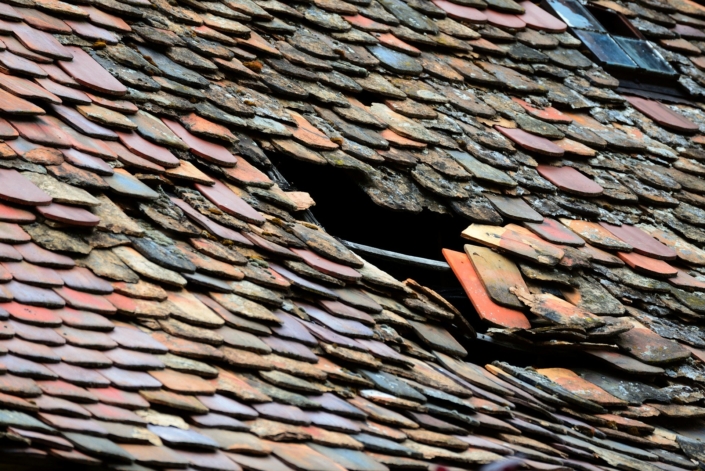
5. Restoration
If walls, floors, or ceilings were removed during the remediation, the final step will be reinstalling what was taken out. Drywall, carpet, and other soft materials are the most likely materials that will have to be replaced. However, even framing or complete ceilings may have to be replaced depending on the level of damage.
Especially if you don’t live in our service area, you should check out our post: How to Choose a Mold Removal Company. We answer every question you should ask a mold removal company, and give you the details you need to know.
4. Remove The Mold
The work will start by removing and discarding non-salvageable material. Next, the materials that can be saved are cleaned. At Branch Environmental, we always use safe and environmentally friendly products. There is no reason to replace one environmental toxin with another, such as bleach. Be sure to ask your mold remediation contractor questions about the chemicals they use to remove mold and if they are environmentally friendly.
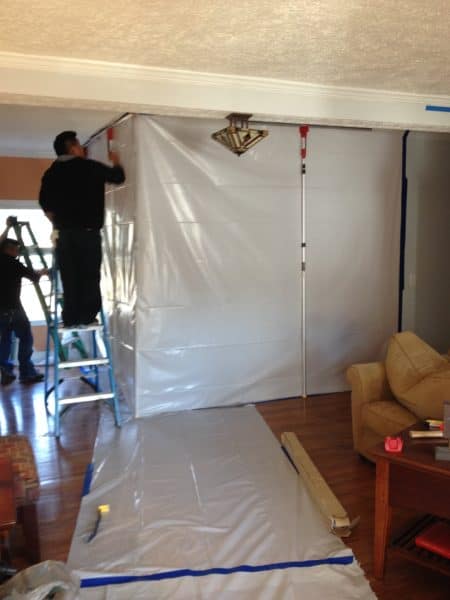
THIS SOUNDS EXPENSIVE!

Most people rarely plan for the expense of mold removal, so here at Branch Environmental, we are careful to help control costs and manage your expectations from the beginning. With a clear understanding of the problem, we can work with you to create a remediation protocol that fits your needs.
The best place to start is with a paid Indoor Air Quality Assessment. This step will give you all the information you need to move forward. You will discover exactly how extensive your problem is, and what is necessary to solve it.

